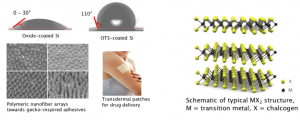Surfaces and interfaces play pivotal roles in diverse fields such as catalysis, electronics, sensors, and photonics. With advances in miniaturization technologies, the role of surfaces has taken center stage, manifesting themselves in mechanical, chemical, electrical and optical properties of materials. Prime examples are nanomaterials, materials in which at least one dimension is between 1 to 100 nm (1 nm = 10
−9 meter). These materials are fundamentally intriguing as they often possess interesting optical, electronic, chemical and mechanical properties, and thus, create new technological opportunities. Furthermore, nature provides many examples of how micro- and nano-scale structures can lead to interesting macroscopic properties, such as adhesive setae in gecko feet and photonic crystals in butterfly wings. Motivated by these and other opportunities, we strive to create materials and surfaces that have useful engineering applications.
Current Research: - Chemical and structural modifications of surfaces (Aifei)
- Large-area growth of 2D materials (Zhou)

Recently Completed Projects
Gecko-inspired Synthetic Adhesives
Geckos are known for their remarkable ability to vertically climb and stick to just about any surface. This is enabled by the hierarchical structures on their feet that range from stiff seta and spatula micro- and nano-structures to millimeter-scale lamellar arrays. Mimicking the multi-scale structure of the geckos has remained a challenge in the field. Utilizing the technique for parallel synthesis of silicon nanowires, master templates can be created with precisely controlled nanowire diameter, length, and density. Subsequent molding yield high-aspect-ratio polymer nanofiber arrays that exhibit high friction with low detachment force. The fibers can be molded with different types of polymers,
e.g., polydimethylsiloxane, polypropylene, low- and high-density polyethylene. Furthermore, schemes are developed to mimic the additional levels of hierarchy into these nanostructures. Such adhesives have many potential applications, such as in biomedical and sports equipment, as well as for crawling micro-robots. Also, fabricating the fiber arrays with tailored geometry allows one to probe how the fundamental parameters of the nanofibers and the contacting substrate (
e.g., fiber and substrate geometry, modulus, and surface energy) affect macroscopic properties like adhesion and friction. This effort provides broader insights for contact between non-ideal surfaces.


